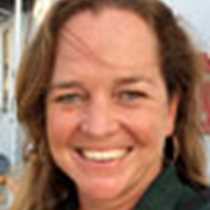Santa Cruz Island
Overnight, the National Geographic Endeavour left the southern islands of the Galápagos and sailed to the central part of the archipelago. The cooler season has begun (although admittedly rather half-heartedly), and the cooler waters are creating an inversion layer that results in a low-lying grey cloud that smothers the higher altitudes of the taller islands. This phenomenon results in a fascinating diversity within the ecological zones of these larger islands, with a distinct zonation pattern that varies in function of both altitude and latitude.
During our long day of exploration of Santa Cruz, second largest of the Galápagos islands, we got to travel from the littoral vegetation zone through arid, transition and Scalesia zones – the latter a valuable remnant of endemic cloud forests that have mostly been displaced by the agricultural zones of these inhabited islands. We started off the morning by driving through the largest human settlement of the Galápagos, slightly stunned by the bustling port activity after several days of completely remote and pristine nature. This settlement is home to the wonderful conservation institutions that have been working hard over several decades to restore the National Park territory to its former glory, with many huge success stories.
One of the joint programs run by the Charles Darwin Foundation (that plays a scientific advisory role) and the Galápagos National Park Service (the governmental institution that plays a management role) is the restoration of the great giant tortoise dynasties. These tortoises colonized the Galápagos millions of years ago and eventually spread among many different islands, giving rise to several separate species, each unique to its own island or even volcano. Unfortunately, over time, many of these species were driven to the brink of extinction through over-harvesting, overpowering competition by introduced mammalian herbivores and direct predation by rats and others.
The most powerful symbol of this tragedy was the famous Lonesome George, a single male tortoise that was the last individual of his species to survive on Pinta Island. Though the Pinta tortoise species has been virtually extinct for years, the plight of this individual cannot but inspire us all to avoid similar tragedies in the future. The recent news of his death rocked the world and we were moved to see the photographic tributes made by local people to this great icon of conservation, in front of the corral where he lived and died.
We subsequently explored Puerto Ayora, before driving up to the highlands to search for individuals from a healthy giant tortoise population in the wild. Many enormous tortoises were found, to the joy and amazement of our younger guests, who were absolutely overwhelmed by the dimensions of these gentle reptiles. We can only hope that the fate of the Pinta tortoise will ensure that we will never allow the same thing to happen to any of the remaining Galápagos tortoise populations, so all future human generations can come and feel the same sense of awe and wonder upon beholding these relics from another era.




